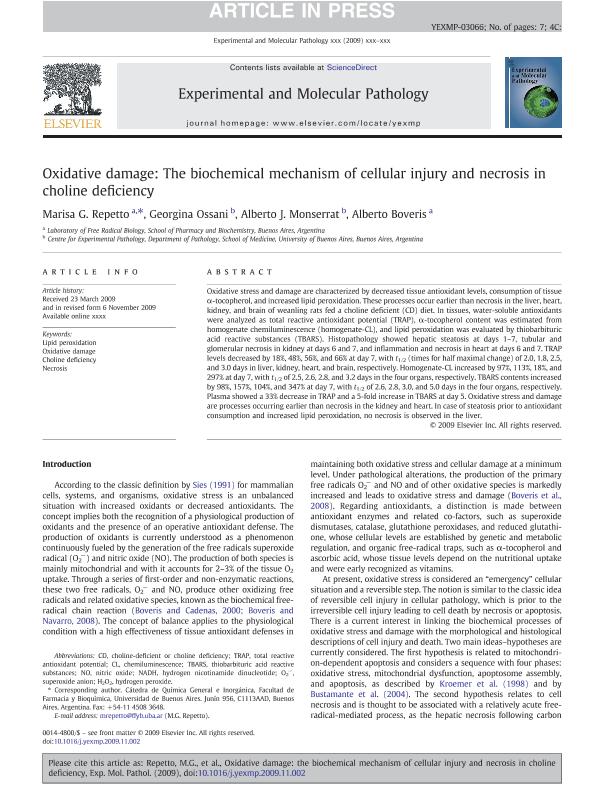Artículo
Oxidative damage: The biochemical mechanism of cellular injury and necrosis in choline deficiency
Repetto, Marisa Gabriela ; Ossani, Georgina Paula
; Ossani, Georgina Paula ; Monserrat, Alberto Juan
; Monserrat, Alberto Juan ; Boveris, Alberto Antonio
; Boveris, Alberto Antonio
 ; Ossani, Georgina Paula
; Ossani, Georgina Paula ; Monserrat, Alberto Juan
; Monserrat, Alberto Juan ; Boveris, Alberto Antonio
; Boveris, Alberto Antonio
Fecha de publicación:
02/2010
Editorial:
Academic Press Inc Elsevier Science
Revista:
Experimental and Molecular Pathology
ISSN:
0014-4800
Idioma:
Inglés
Tipo de recurso:
Artículo publicado
Clasificación temática:
Resumen
Oxidative stress and damage are characterized by decreased tissue antioxidant levels, consumption of tissue α-tocopherol, and increased lipid peroxidation. These processes occur earlier than necrosis in the liver, heart, kidney, and brain of weanling rats fed a choline deficient (CD) diet. In tissues, water-soluble antioxidants were analyzed as total reactive antioxidant potential (TRAP), α-tocopherol content was estimated from homogenate chemiluminescence (homogenate-CL), and lipid peroxidation was evaluated by thiobarbituric acid reactive substances (TBARS). Histopathology showed hepatic steatosis at days 1-7, tubular and glomerular necrosis in kidney at days 6 and 7, and inflammation and necrosis in heart at days 6 and 7. TRAP levels decreased by 18%, 48%, 56%, and 66% at day 7, with t1/2 (times for half maximal change) of 2.0, 1.8, 2.5, and 3.0 days in liver, kidney, heart, and brain, respectively. Homogenate-CL increased by 97%, 113%, 18%, and 297% at day 7, with t1/2 of 2.5, 2.6, 2.8, and 3.2 days in the four organs, respectively. TBARS contents increased by 98%, 157%, 104%, and 347% at day 7, with t1/2 of 2.6, 2.8, 3.0, and 5.0 days in the four organs, respectively. Plasma showed a 33% decrease in TRAP and a 5-fold increase in TBARS at day 5. Oxidative stress and damage are processes occurring earlier than necrosis in the kidney and heart. In case of steatosis prior to antioxidant consumption and increased lipid peroxidation, no necrosis is observed in the liver.
Palabras clave:
CHOLINE DEFICIENCY
,
LIPID PEROXIDATION
,
NECROSIS
,
OXIDATIVE DAMAGE
Archivos asociados
Licencia
Identificadores
Colecciones
Articulos(OCA HOUSSAY)
Articulos de OFICINA DE COORDINACION ADMINISTRATIVA HOUSSAY
Articulos de OFICINA DE COORDINACION ADMINISTRATIVA HOUSSAY
Citación
Repetto, Marisa Gabriela; Ossani, Georgina Paula; Monserrat, Alberto Juan; Boveris, Alberto Antonio; Oxidative damage: The biochemical mechanism of cellular injury and necrosis in choline deficiency; Academic Press Inc Elsevier Science; Experimental and Molecular Pathology; 88; 1; 2-2010; 143-149
Compartir
Altmétricas



